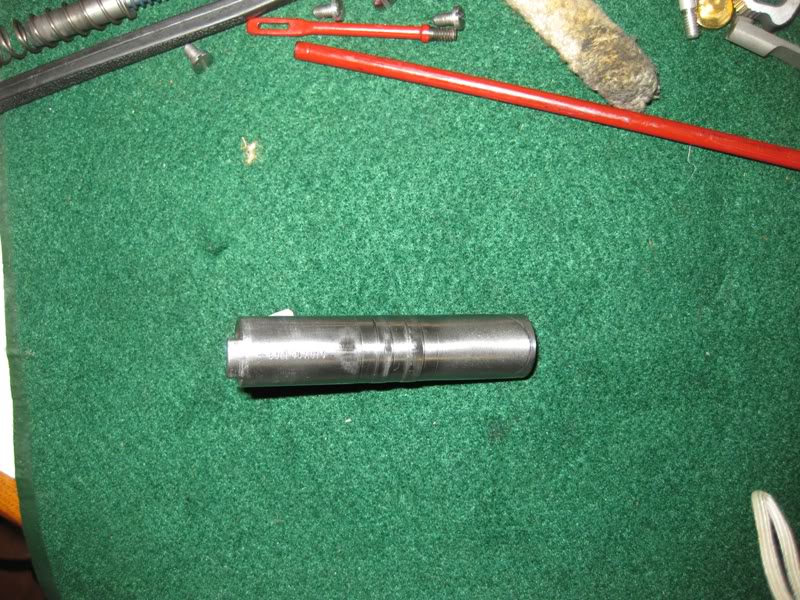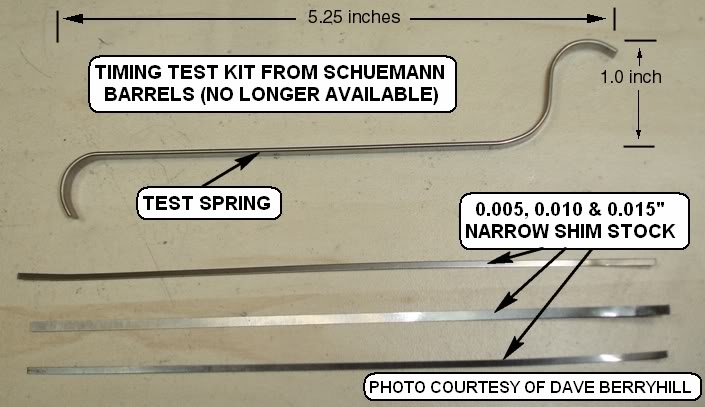
These marks are after about 140 rounds through a new Defender. Almost all WWB but a few Golden Sabre. Sorry, this was the best photo I got...
They look bad. Any thoughts?

That's just rub marks from the underside of the slide and may indicate the barrel is not dropping down far enough. Remove the recoil spring and pull the slide back about 3/4". Use a narrow strip of carbon paper as a feeler gauge (or 0.0005" feeler gauge) to see if the back of the barrel has fallen all the way down to its bed in the frame.
Then, push down on the back of the barrel as before, move the slide forward until it stops without lifting the barrel and use feeler wires or narrow strips of paper or card stock to measure the gap between the top of the barrel and the underside of the slide.
What did you find?
I hope I figured this out. I got out my old spark plug flat blade gap gauges, and I could not get the "5" gauge under the rear of the barrel, measuring through the ejection port. I also put some pressure on the rear of the barrel, slid the slide forward, and when the slide stopped, I could get the corner of the "22" gauge in the gap between the rear of the barrel and the top of the slide, again through the ejection port, but not the "23"
Does that help?
How are the edges of the locking lugs, on the barrel and in the slide? If they are square and nice, I wouldn't worry about the marks on the top of the chamber.
Quote:
Does that help?
It helps a little, but check for the lugs crashing that John mentioned by removing the recoil spring, inverting the gun (cleaned but not oiled), put it into battery, point the muzzle up at about 45deg and slowly pull back the slide about 3/8".
The slide should come back smoothly with no hesitation. If you feel (or hear) any hesitation it means the barrel isn't getting away from the slide fast enough and the radial locking lugs are crashing. If you feel any hesitation, do the more elaborate linkdown timing tests from Schuemann Barrels which can be found in our Tech Issues section.
But if the barrel comes back smoothly without hesitation it means the radial locking lugs are not crashing and their corners should be square (or fairly square) with no signs of peening or battering. If so, shoot it and enjoy it. And don't fret over the rub mark. It's a gun. Gun parts rub against each other all the time. This one's just out in the open where it can be seen.
You mean to do the test with the gun upside down??
Yes. That allows gravity to pull the barrel down toward the slide and put the link into tension, as it would be after firing right-side-up when the link is in tension and pulling the barrel down toward the bed and VIS. It's nothing more than a version of what Schuemann does in his timing tests to insure the barrel is vertically disengaged from the slide before its lower lugs contact the VIS. But the Schuemann method is done with the gun right-side-up with a special tool/spring...

...to keep the link in tension. Turning the gun upside down just lets gravity do the job of the tool - provided the gun is clean.
If there's any hesitation, hitch or click doing it either way, it's a sign vertical disengagement has not been completed by the time the barrel lugs hit the VIS - causing the lugs to crash and get their corners damaged as you mentioned.
P.S.: Army Ordnance specs for the Government Model slide and barrel call for their lug corners to be chamfered or radiused 0.010 to 0.015 inch, so that (if done) should not be confused with a sign of crashing.
I just want to make sure that since this is a Defender, "remove the recoil spring" actually means to remove the entire recoil "apparatus," including the little bushing that holds the recoil spring in the front of the slide?
Uh-oh. I forgot about this being a Defender and I'm not familiar with it. But after looking at the illustrated parts breakdown on Colt's website it seems like the test can still be done with the entire recoil assembly removed.
Removing the recoil spring is just to make it easier for you to detect any hitch or hesitation when the slide is moved back.
I pulled the recoil assembly, reassembled the pistol and performed the test. the slide moves maybe 1/16 of an inch before it hesitates. A bit more pressure and the slide moves back smoothly. It looks like the top of the sear is causing the stoppage, as the hesitation is the same with or without the barrel installed. The barrel does click when it is installed and the slide is moved, and that is when it locks down in the frame.
I can't see any peening or a burr or wear on any of the barrel lugs. I see 2 tiny points of impact on the frame, apparently from the lower barrel lug corners, and no visible slide lug wear...
Is this a good thing, or should I be more confused?
That hesitation at 1/16" occurs when the slide pushes the disconnector down. A hesitation due to lug crashing would be felt when the slide's back about 1/4". That, coupled with your report of good-looking lugs, leads me to believe the gun's OK.
You are right, it is the disconnector. I can see the barrel drop (rise, actually, since the gun is inverted) when the slide moves past the disconnector, and there is a slight click, but no hesitation on the slide after it clears the disconnector. Those rub marks look terrible though. I may call Colt anyway and see what they think they can do since the pistol is brand new..
Quote: ... no hesitation on the slide after it clears the disconnector.
The hesitation (hitch) you were looking for and the one that would indicate the lugs were crashing would have occurred looong before the disconnector became visible. About 1-1/2" before the disconnector became visible.
As previously mentioned, lug crashing (if it occurs) occurs when the lower lugs contact the VIS. And the lower lugs contact the VIS when the barrel is about 1/4" out of battery. If your disconnector doesn't go down easily and you think it may be masking the hesistation, remove the disconnector.
I don't think it's masking the hesitation. After it clears, the slide moves very nicely. I did call Colt today, and spoke to Rob. He stated on the Defenders, the barrel wear I was experiencing is normal because of the small size of the gun and the fact that everything is closer together and moving faster. He did say if there is a function problem, they would want to look at it then.
I am not completely satisfied with this because of how bad the wear looks on the barrel. Anyone else having this problem with a Defender or have you seen this issue?
I don't recall ever seeing a 1911 that DIDN'T show some wear in that area. I know that in theory it's not supposed to happen ... but we're living in the real world, not a theoretical world. If your Defender functions okay ... shoot it.